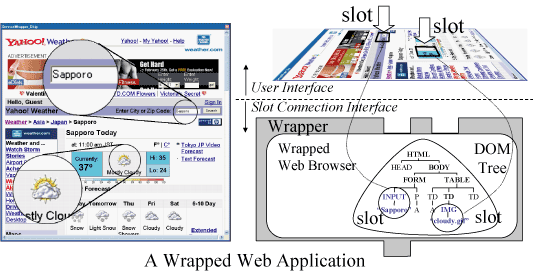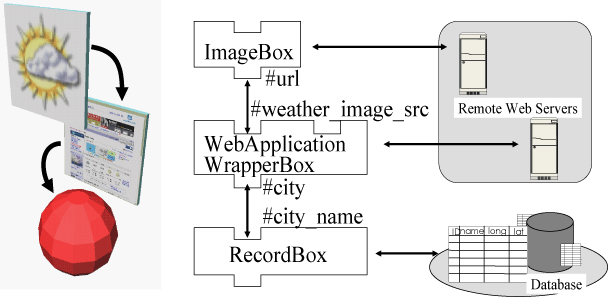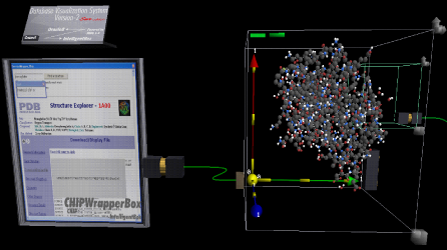
This paper proposes a new visualization and reification framework for the integrated interactive access and reuse of both database records and Web content including service. The framework integrates the database visualization and reification framework and the Web application wrapping framework. The Web application wrapping framework allows users to specify arbitrary HTML nodes on an arbitrary Web page to work as IO ports called slots, and to wrap this page to work as a 2D meme media object. Our new framework introduces a 3D proxy meme media object for a wrapped Web application, and allows users to register such a proxy object as a record reification template in our 3D database visualization and reification framework.
Web application wrapping, Database visualization.
Recent development of information technologies in various fields of science and technology has remarkably accelerated both the accumulation of data in databases and the publication of multimedia documents as well as services such as database services, reference services and data analysis services in the Web. Researchers and analysts need an interactive visual interface for the integrated access of both such databases and the Web.
This paper proposes a new visualization and reification framework for the integrated interactive access and reuse of both database records and Web content including service. Since each visual object in this framework may be a functional interactive object, we call this framework a reification framework. The reification of each object as a 3D interactive visual component is based on the meme media technologies developed by Y. Tanaka's research group [3].
Our framework has integrated the database visualization and reification framework and the Web application wrapping framework. These two frameworks that Y. Tanaka's group has already proposed are both based on meme media technologies. The database visualization and reification framework allows users to visually compose both a database query and a visualization scheme, reifies each retrieved records as interactive 3D visual component, and arranges all the reified records in the specified visualization scheme. The record reification uses a 3D composite meme media object as a template, and instantiate its parameters with the attribute values of each record. The Web application wrapping framework allows users to specify arbitrary HTML nodes on an arbitrary Web page to work as IO ports called slots, and to wrap this page to work as a 2D meme media object. Our new framework introduces a 3D proxy meme media object for a wrapped Web application, and allows users to register such a proxy object as a record reification template in database visualization and reification framework.
K. Ito and Y. Tanaka[1] proposed a framework in which users can wrap an arbitrary remote Web application to define an interactive visual component with IO ports, and to functionally combine more than one such component together through port connections.

To create a wrapped visual component of a Web application, users may just open the Web page they want to wrap using a WebApplicationWrapperPad, which is a kind of Web browser in the 2D meme media system IntelligentPad. The WebApplicationWrapperPad allows users to specify arbitrary HTML-nodes and/or arbitrary text strings on the specified Web page as IO ports called slots (Figure1). Specified HTML nodes may include input forms and output text strings on the Web page. The WebApplicationWrapperPad holds only the HTML-path of the specified HTML node in the DOM tree to access the value of each user-defined slot [1]. An HTML-path is a specialization of an XPath expression.
Our DB visualization and reification framework uses a 3D meme media system IntelligentBox as its platform, and allows users to specify both a query and a visualization scheme as a query flow diagram of query operator components[2]. The framework models both relational query operations and visualization schemes as query modifications to modify their input relational views, and provides a 3D visual component for each of them. An interactively defined appropriate flow connection of such components defines a relational view, and each visualization component in this flow diagram evaluates its input relational view to access the database and to reify retrieved records in a specified arrangement. One of the query operator components allows users to register an arbitrary visual composite object defined in the 3D meme media system IntelligentBox as the template to reify each retrieved record. Whenever a visualization component instantiates the template for each retrieved record, it also evaluates the instantiated template. This means that the instantiation also invokes the procedure or the process implemented in the template.
Our new framework for visualizing and reifying DB and Web content uses a visual 3D proxy component for a wrapped Web application in 2D representation as a component to define a composite template to reify each record in the database visualization and reification framework described in Section 3. Users may combine arbitrary components together with the proxy of an arbitrary wrapped Web application to embed Web page access and content extraction functions in each reified record. The instantiation of the template for each record evaluates these functions, and, for example, displays, for each record, content of the Web page that may accept an attribute value of this record as a query input and return the result as its content.
Suppose that we have a database storing the locations and names of cities in various districts. Suppose that you want to visualize the locations and weathers of these cities in an arbitrarily selected district. What you need to do are just the followings. First, you need to define a wrapped Web application as a pad for some weather information service Web page. You need to specify its input form for a city name and the weather symbol image portion of the output content to work as slots. Then, you need to export this wrapped Web application to the DB visualization and reification environment to create its proxy as a 3D component.

Now, you can use this proxy as a component to define a record reification composite template. Figure2 shows such a template with a component accessing a weather forecast Web site. The proxy WebApplicationWrapperBox has two slots, one slot is to input a city name, the other to output a URL of the weather symbol image retrieved from the Web application (see Figure2.). An ImageBox connected to the second slot of this proxy will display the output image that is downloaded from the URL in #url slot. Now you can define a query flow diagram, using query operators and registering the defined composite template as a record reification template. Figure3 is a 3D database reification environment using a WebApplicationWrapperBox as a component of the record reification template. The TableBox at the leftmost reads the table data stored in the database. The TemplateManagerBox selects the attribute "a city" of the table, and sends the attribute data to the registered template. The WebApplicationWrapperBox in each copy of the template accesses the weather forecast Web page with the value of the attribute "a city", and displays the image downloaded from the value of the #url slot. Moreover, the box showing the background map converts each city name to a location on this map. The weather of each city obtained from the Web is automatically displayed on a map.

Figure4 shows a protein structure reification using a WebApplicationWapperBox and a ProteinBox. The WebApplicationWrapperBox retrieves the 3D structure data for a specified protein from the Protein Date Bank (PDB) service on the Web, and sends the retrieved data to the ProteinBox. As a result, the ProteinBox reifies the 3D structure of the protein for direct manipulation.

Our new framework provides an easy way of accessing both a database and the Web with mutual relationship between them and visualizing and/or reifying database records with related Web content for each of them. The framework is based on a visual component software architecture, and allows users to dynamically combine components to define arbitrary queries and visualization schemes together with simultaneously visualized related Web content.